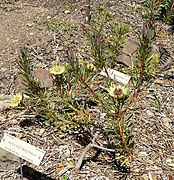Protea scolymocephala
Appearance
| Protea scolymocephala | |
|---|---|

| |
| Scientific classification | |
| Kingdom: | Plantae |
| Clade: | Tracheophytes |
| Clade: | Angiosperms |
| Clade: | Eudicots |
| Order: | Proteales |
| Family: | Proteaceae |
| Genus: | Protea |
| Species: | P. scolymocephala
|
| Binomial name | |
| Protea scolymocephala | |

| |
| Protea scolymocephala distribution
Extant (resident)
| |
| Synonyms[2] | |
Protea scolymocephala, also known as the thistle protea[3][4] or thistle sugarbush,[5][4][6][7] is a flowering plant from the genus Protea native to South Africa.[7]
Other recorded
Afrikaans language it is known by the name of kleingroenroos, or alternatively witskollie.[4]
Taxonomy
Protea scolymocephala was first
described by Linnaeus as Leucadendron scolymocephalum,[2] but moved to the genus Protea by Johann Jacob Reichard in 1779 or 1780.[8]
Description
It is a small, erect
monoecious with both sexes in each flower.[7] The fruits are persistent, which means they are retained on the plant after drying.[3][7] The seeds stored within the fire-resistant, dried fruit, and when released after fires are dispersed by means of wind.[5][7]
Individual plants generally have a generational length of some 20 years.[5]
Distribution
P. scolymocephala is
endemic to the Western Cape province of South Africa,[5] where it is found from approximately the Olifants River[3] and the Gifberg[5][7] in the north, through Cape Town,[3][7] to Hermanus in the east,[5][3] and from Kleinmond to Hawston in the west.[7] It grows on the Slangkop headland on the Cape Peninsula.[6]
Gallery
-
Protea scolymocephala cultivated at Paarlberg Nature Reserve, Paarl, Western Cape, South Africa
-
habitus of plant cultivated at the University of California Botanical Garden in Berkeley
-
habitus at Auckland Botanic Gardens, New Zealand
-
developing inflorescence at the University of California Botanical Garden
-
leaves and flowerheads at the Caledon Wild Flower Show inCaledon, Western Cape
Ecology
It grows in sandy flats (
sandveld) and coastal lowlands,[5][3][6] and is often found growing near drainage lines. It is found from altitudes of 0 to 400 metres.[5]
The mature plants are usually completely killed by wildfires, but the seeds can survive such events within the fire-resistant inflorescences.[5][7]
It is pollinated by birds and rodents. The roots are eaten by
mole rats.[5]
Conservation
In 1998 it was said to be largely
habitat degradation and other intrinsic factors such as changes in native species dynamics.[5]
References
- . Retrieved 18 November 2021.
- ^ a b c "Protea scolymocephala Reichard". Plants of the World Online. Kew Science. 2017. Retrieved 19 July 2020.
- ^ ISBN 1-874950-40-7.
- ^ a b c d Notten, Alice (August 2006). "Protea scolymocephala (L.) Reichard". PlantZAfrica. South African National Biodiversity Institute. Retrieved 19 July 2020.
- ^ a b c d e f g h i j k Rebelo, A.G.; Mtshali, H.; von Staden, L. (17 April 2005). "Thistle Sugarbush". Red List of South African Plants. version 2020.1. South African National Biodiversity Institute. Retrieved 16 July 2020.
- ^ a b c d e "Protea scolymocephala (Thistle sugarbush)". Biodiversity Explorer. Iziko – Museums of South Africa. Retrieved 16 July 2020.
- ^ a b c d e f g h i j k l "Rose Sugarbushes – Proteas". Protea Atlas Project Website. 11 March 1998. Retrieved 16 July 2020.
- ^ "Protea scolymocephala | International Plant Names Index". www.ipni.org. The Royal Botanic Gardens, Kew, Harvard University Herbaria & Libraries and Australian National Botanic Gardens. Retrieved 19 July 2020.
External links
 Media related to Protea scolymocephala at Wikimedia Commons
Media related to Protea scolymocephala at Wikimedia Commons






